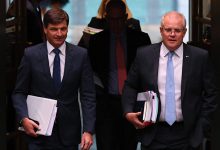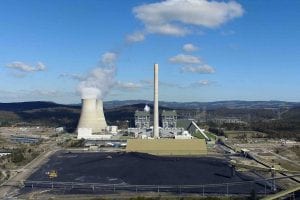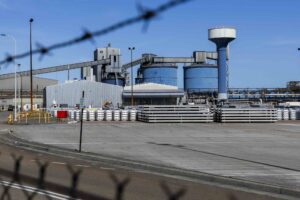Australia has recorded a slight drop in emissions for the year to June 2019, according the latest official data shows, but with little cause for celebration – as the fall is largely the result of both damaging drought and floods that have dented impacted agricultural production.
Large portions of Australia have suffered under prolonged drought conditions, leading the Morrison government to undertake emergency response measures. Dry conditions have also contributed to an “unprecedented” early start to Australia’s bushfire season, triggering a contentious debate over the contribution of climate change.
These same conditions, drought along with severe flooding in Queensland, have both caused a substantial decline in stock numbers and have, perversely, been the largest contributor to a fall in Australia’s emissions over the last 12 months.
The latest quarterly emissions update released by the government showed that agricultural emissions fell 5.9 per cent in the year.
The environment department said that drought throughout Australia has led to a decline in sheep and cattle herd numbers, while flooding in Queensland led to the loss of around 60,000 head of cattle. Drought has also caused a substantial decline in crop production, with a lack of available water reducing cotton production in NSW by up to 50 per cent, and causing rice production to drop by almost 90 per cent.
Water shortages have contributed to a significant decline in the production of sheep and cattle and is probably not an outcome the Morrison government should be celebrating. Australia’s emissions would have increased, if not for the drought-driven decline in agricultural emissions.

Emissions in the electricity sector continued to decline, falling by 1.2 per cent in the year to June 2019. With a ramp-up in renewable energy investment as the 2020 target approaches, seeing the electricity sector continuing to do a lot of the heavy lifting when it comes to emissions reductions, with emissions rising in other sectors.
Electricity continues to represent the largest source of Australia’s emissions, followed by industrial energy use and transport.
Fugitive emissions continued to rise, recording a 4.4 per cent increase, as did stationary energy emissions which increased 3.6 per cent. Both have likely been driven higher as a result of increases in LNG production, as Australia continues to ramp up its gas exports.
Federal minister for emissions reduction Angus Taylor welcomed the slight decline in annual emissions, and repeated his (disputed) claims that the increases in fugitive emissions should be celebrated because Australia’s gas exports will displace higher emissions sources of energy overseas.
Additionally, following a revision of historical emissions figures, the data released by the Department of Environment and Energy suggests that emissions in earlier years were higher than originally reported, leading Taylor to claim that emissions had fallen to its lowest level since the Coalition came to power in 2013.
“New data highlighted in the report reveals that emissions are lower than when the Coalition came into Government and are at their lowest level since 2015-16,” Taylor said.
For example, the latest version of the quarterly emissions inventory released today shows emissions for the 2013 financial year at 537.6 million tonnes CO2-e. In previous reports, including a report released as recently as September 2018, showed that 2013 emissions were thought to be as a low as 514.1 million tonnes.
While Taylor can use the revised figures to claim emissions have fallen since 2013, based on the revised figures, the uplifted data suggests Australia’s overall emissions have been notably higher than originally first thought.
“The report also outlines the impact of emissions from Australian exports in recent years, which have placed upward pressure on Australia’s total emissions even as these exports lower global emissions. For example, by displacing more emissions-intensive fuels,” Taylor said.
“The Government welcomes these developments as we deliver our $3.5 billion Climate Solutions Package, which maps out to the last tonne how we will meet our 2030 Paris target,” Taylor said.
The result was criticised by Greens climate spokesperson Adam Bandt, who said that it was ironic that emissions were now falling as a result of factors that will only be made worse by climate change.
“Drought is not an acceptable pollution reduction strategy,” Bandt said.
“The climate emergency is so bad that now the climate-induced drought is even bigger than the lift in fossil-fuel pollution. The sad irony in these figures is that this small drop in pollution is itself due to climate inaction.”
“With the European Parliament just declaring a climate emergency and our trade at risk because of climate inaction, these figures reinforce Australia’s status as a climate outlaw,” Bandt added.
This critique was echoed by the Australian Conservation Foundation, which called on the Morrison government to establish meaningful policies to reduce Australia’s emissions.
“Climate change is accelerating, and this is dramatically affecting agricultural production. Without the decline in agricultural emissions driven by the effects of worsening climate change, Australia’s emissions for the year to June 2019 would be increasing,” ACF’s economy and democracy program director Matt Rose said.
“The Morrison Government still has no effective climate policy and continues to promote the expansion of coal and gas production.”
“As a major exporter of coal and gas, with abundant renewable energy resources, Australia has an important role to work with other countries to reduce global emissions and an opportunity to build a world-leading renewable energy industry.”
For the first time, the environment department has produced an estimate of “consumption” related emissions, to account for Australia’s trade in goods.
Effectively this estimate deducts emissions that are associated with Australia’s exports, such as fugitive emissions reduced in the production of LNG, as they relate to resources used by other countries while adding in emissions associated with goods imported and used in Australia.
The department argues that based on a “consumption” analysis, Australia’s responsible emissions have declined. This primarily reflects the differences in goods exported and imported by Australia. Australia exports higher proportions of fossil fuels, including coal and gas, while it primarily imports value-added goods, such as vehicles, machinery, electrical goods and technical services.

Taylor was denied an opportunity to head overseas early to attend upcoming energy and climate change conferences in Paris and Madrid after the Labor opposition refused to grant Taylor a voting “pair” in the parliament.
Taylor would likely have been keen to skip the final sitting week in parliament, has both he and prime minister Morrison continue to face scrutiny over the use of fabricated figures in a letter from Taylor to Sydney lord mayor Clover Moore.
Taylor will instead miss a ministerial meeting to be convened by the International Energy Agency in Paris, remaining in Canberra for the final sitting week, and will then head to Spain for the second week of the UN climate talks to be held in Madrid.









